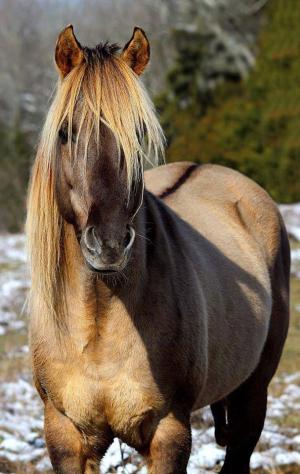History
For over 200 years, the saddle horse has lived in the hills and valleys of eastern Kentucky. Originally bred by the mountain people for the demanding needs of farm life, the horse which had been secluded for many years became noticed and domesticated in the late 1980's. Over the last 20 some years these horses have become a highly sought after "pleasure horse" in all of Kentucky as well as around the world, for their easy going temperament, intelligence, versatility, willingness, and most notably, a smooth, natural 4-beat gait. Many members of long-time Kentucky families remember well the stories of the many extraordinary feats that were told about these horses by their grandfathers and great grandfathers around the dinner table.
In 1989, Robert Robinson, Jr., a native of Irvine, Kentucky formed the Kentucky Mountain Saddle Horse Association (KMSHA) to document and preserve the ancestry and rich heritage of the mountain saddle horse. In 2002 the Kentucky Mountain Horse Association (SMHA) was formed, (a subsidiary of the KMSHA) to register mountain horses that had "spots" of white that were considered to much coverage for any of the existing mountain horse breeds, in order to meet their solid color standards.
This Kentucky Mountain Saddle Horse and the Kentucky Mountain Horse breeds, each with their own distinctive characteristics and genetic DNA markers, are recognized by the University of Kentucky, Equine Parentage Testing and Genetic Research Center as their own unique breed of Horse. The KMHA has closed its books and has been working with the University of Kentucky to continue to identify new genetic markers that will further enhance the breed. The SMHA's books are still open.
Behavior
N/A
Function
The Kentucky Mountain Saddle Horse is a horse breed from the U.S. state of Kentucky. Developed as an all-around farm and riding horse in eastern Kentucky, it is related to the Tennessee Walking Horse and other gaited breeds. In 1989 the Kentucky Mountain Saddle Horse Association (KMSHA) was formed, and in 2002, the subsidiary Spotted Mountain Horse Association (SMHA) was developed to register Kentucky Mountain Saddle Horses with excessive white markings and pinto patterns. Conformation standards are the same for the two groups of horses, with the main difference being the color requirements. The KMSHA studbook is now closed to horses from unregistered parents, although it cross-registers with several other registries, while the SMHA studbook remains open.






